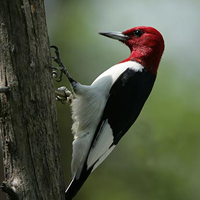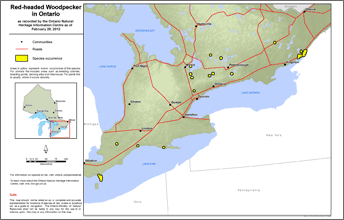Red-headed woodpecker
Scientific name: Melanerpes erythrocephalus

Photo credit: iStockPhoto.com
Status
Endangered
Endangered
means the species lives in the wild in Ontario but is facing imminent extinction or extirpation.
Date added to the Species at Risk in Ontario list
The Red-headed Woodpecker was already assessed as at-risk when the Endangered Species Act took effect in 2008.
Read the most recent assessment report (PDF)
What it looks like
The Red-headed Woodpecker is a medium-sized bird – about 20 centimetres long – easily recognized for its vivid red head, neck and breast. The rest of the bird is black and white, mostly white underneath and black on top.
This woodpecker’s strong bill helps it dig holes in wood to find insects, its food source in the summer. In the winter, it eats nuts.
Adults often return to the same nesting site year after year. Between May and June, females lay from three to seven eggs. Both parents incubate the eggs and then tend to the young.
Where it lives
The Red-headed Woodpecker lives in open woodland and woodland edges and is often found in parks, golf courses and cemeteries. These areas typically have many dead trees, which the bird uses for nesting and perching.
This woodpecker regularly winters in the United States, moving to locations where it can find sufficient acorns and beechnuts to eat. A few of these birds will stay the winter in woodlands in southern Ontario if there are adequate supplies of nuts.
Where it’s been found in Ontario
The Red-headed Woodpecker is found across southern Ontario, where it is widespread but rare. Outside Ontario, it lives in Alberta, Saskatchewan, Manitoba and Quebec, and is relatively common in the United States.
View a Larger version of this map (PDF)
What threatens it
Threats to the Red-headed Woodpecker include:
- loss of nesting sites and suitable habitat
- reduction in food supply
- collisions with buildings, vehicles, utility towers and power lines causing harm or death
- competition for nesting sites with the introduced European Starling
- predators like domesticated cats and Cooper’s and Sharp-shinned Hawks
Action we are taking
Endangered Species and their habitat are protected under Ontario’s Endangered Species Act, 2007.
Recovery strategy
A recovery strategy advises the ministry on ways to ensure healthy numbers of the species return to Ontario.
Read the executive summary and the full document (September 6, 2022).
Government response statement
A government response statement outlines the actions the government intends to take or support to help recover the species.
Read the government response statement (June 6, 2023)
What you can do
Report a sighting
- Report a sighting of an endangered animal or plant to the Natural Heritage Information Centre. Photographs with specific locations or mapping coordinates are always helpful.
- Bird Studies Canada is working to advance the understanding, appreciation and conservation of wild birds and their habitat in Ontario and elsewhere. For more information on how you can help, visit: birdscanada.
- The Carolinian forests of southern Ontario support an amazing diversity of plants and wildlife, including many species at risk. Carolinian Canada is working to help recover species at risk and their habitats. For more information, visit: caroliniancanada.
Volunteer
- Volunteer with your local nature club or provincial park to participate in surveys or stewardship work focused on species at risk.
Be a good steward
- Private land owners have a very important role to play in species recovery. You may be eligible for stewardship programs that support the protection and recovery of species at risk and their habitats.
Report illegal activity
- Report any illegal activity related to plants and wildlife to
1-866-MOE-TIPS (663-8477) .
Quick facts
- In addition to a bill, woodpeckers have special anatomical features to help them dig holes in wood and find insects. A covering of feathers over the nostrils keeps out pieces of wood and wood powder. A long, barbed tongue searches crevices and cracks for food. And the bird’s salivary glands produce a glue-like substance that coats the tongue and, along with the barbs, helps it capture insects.
- Red-headed Woodpeckers store food, hiding insects and seeds in cracks in wood, under bark, in fence posts, and under roof shingles.
